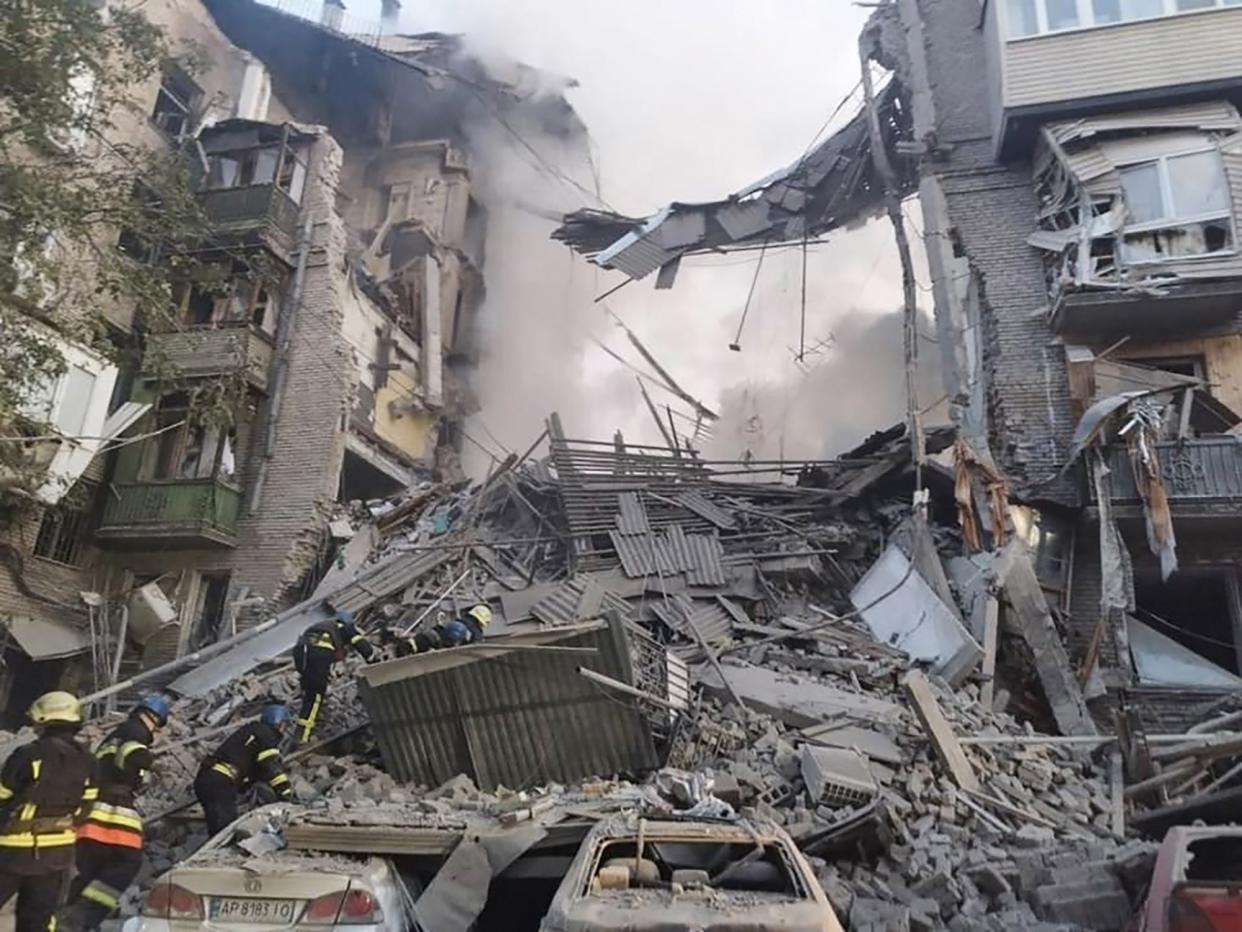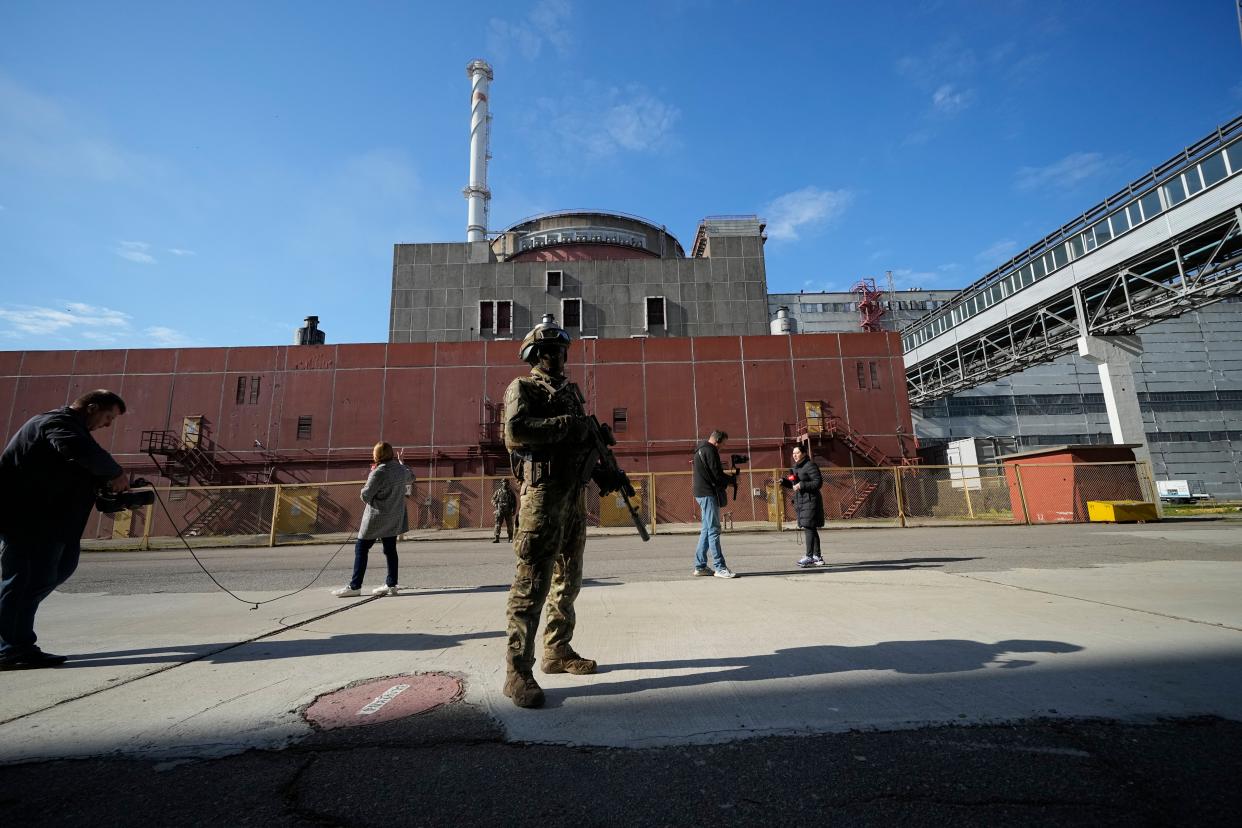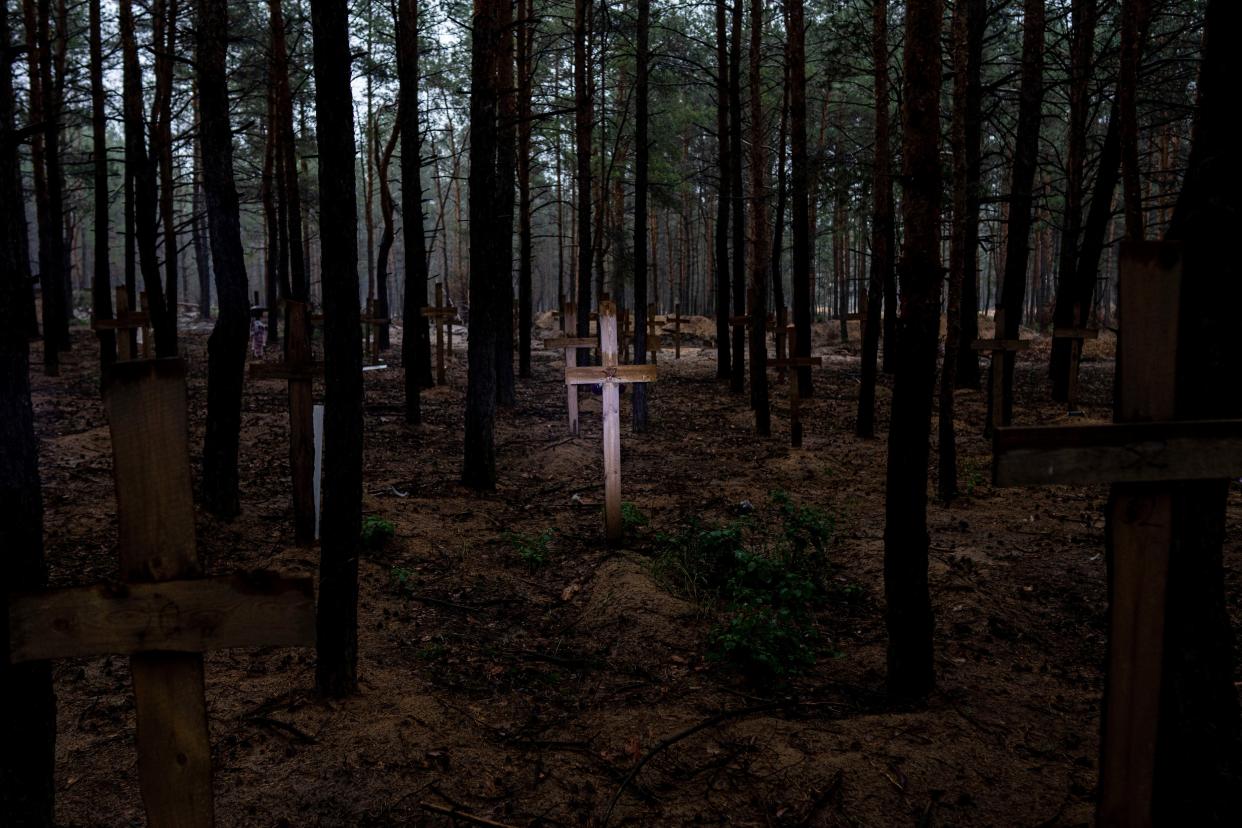Russia strikes annexed area; more bodies found in Kharkiv
KYIV, Ukraine — Russia concentrated attacks Friday in its increasingly troubled invasion of Ukraine on areas it illegally annexed as the death toll from earlier missile strikes on apartment buildings in the southern city of Zaporizhzhia rose to 12.
In a rebuke to Russian President Vladimir Putin and his conduct of Europe’s worst armed conflict since World War II, the Norwegian Nobel Committee awarded the Nobel Peace Prize to human rights organizations in his country and Ukraine, and to an activist jailed in Russia’s ally Belarus.

In this photo provided by the Ukrainian Emergency Service, rescuers work at the scene of a building damaged by shelling in Zaporizhzhia, Ukraine, Thursday, Oct. 6, 2022.
Berit Reiss-Andersen, the committee’s chair, said the honor went to “three outstanding champions of human rights, democracy and peaceful coexistence.”
This week, Putin illegally claimed four Ukraine regions as Russian territory, including the Zaporizhzhia region that is home to Europe’s largest nuclear power plant, whose reactors were shut down last month.
Fighting near the Russian-occupied Zaporizhzhia Nuclear Power Plant has alarmed the U.N.’s atomic energy watchdog, which on Friday doubled to four the number of its inspectors monitoring plant safeguards. An accident there could release 10 times more potentially lethal radiation than the world’s worst nuclear disaster at Chernobyl in Ukraine 36 years ago, Ukrainian Environmental Protection Minister Ruslan Strilets said Friday.

Foreign journalists work as a Russian soldier patrols an area at the Zaporizhzhia Nuclear Power Station, in Enerhodar, Zaporizhzhia region, in territory under Russian military control, southeastern Ukraine, on May 1, 2022. (Alexander Zemlianichenko/)
“The situation with the occupation, shelling, and mining of the Chernobyl and Zaporizhzhia nuclear power plants by Russian troops is causing consequences that will have a global character,” Strilets told The Associated Press.
The city of Zaporizhzhia is located 33 miles away from the nuclear plant as a crow flies and remains under Ukrainian control. To cement Russia’s claim to the region, Russian forces bombarded the city with S-300 missiles on Thursday, with more attacks reported Friday.
Ukrainian authorities said the death toll from the strikes on apartment buildings rose to 12 on Friday, while another 12 people wounded in the bombardment remained hospitalized.
Missiles also struck the city overnight, wounding one person, Zaporizhzhia Gov. Oleksandr Starukh said. Russia also used Iranian-made Shahed-136 drones there for the first time and damaged two infrastructure facilities, he said.
With its army losing ground to a Ukrainian counteroffensive in the south and east, Russia has deployed unmanned, disposable Iranian-made drones that are cheaper and less sophisticated than missiles but still can damage targets on the ground.
The Washington-based Institute for the Study of War said Russia’s use of the explosives-packed drones was unlikely to affect the course of the war.
“They have used many drones against civilian targets in rear areas, likely hoping to generate nonlinear effects through terror. Such efforts are not succeeding,” analysts at the think tank wrote.
In other Moscow-annexed areas, Russia’s Defense Ministry reported Friday that its forces had repelled Ukrainian advances near the city of Lyman and retaken three villages elsewhere in the eastern Donetsk region. The ministry also claimed that Russian forces had prevented Ukrainian troops from advancing on several villages in the southern Kherson region.
Ukrainian President Volodymyr Zelenskyy said in his nightly video address Friday that this week alone, his military has recaptured 300 square miles of territory in the east and 29 settlements, including six in the Luhansk region, which Putin has annexed. In total, Ukrainian forces have liberated 940 square miles of land and 96 settlements since the beginning of its counteroffensive.
In Ukraine’s Dnipropetrovsk region, Russian troops shelled the city of Nikopol overnight, killing one person, wounding another and damaging buildings, natural gas pipelines and electricity systems, the region’s governor reported. Nikopol lies along the Dnieper River across from Russian-held territory near the nuclear plant. The city has been shelled constantly for weeks.
The trail of Russia’s devastation and death from areas where its troops retreated became clearer Friday. A report by Ukrainian First Deputy Minister of Internal Affairs Yevhen Yenin revealed that 530 bodies of civilians have been found in Ukraine’s northeastern Kharkiv region since Sept. 7.

Unidentified graves of civilians and Ukrainian soldiers are marked with a cross in a cemetery in the recently liberated town of Izium, Ukraine, Thursday, Sept. 15, 2022. At the mass grave site created by the Russians and discovered in the woods of Izium, at least 30 of the 447 bodies recently excavated bore visible marks of torture – bound hands, close gunshot wounds, knife wounds and broken limbs, according to the Kharkiv regional prosecutor's office. (Evgeniy Maloletka/)
The residents killed during the Russian occupation included 257 men, 225 women and 19 children, with 29 people unidentified, Yenin said. Most of the bodies were found in a previously disclosed mass grave in the city of Izium.
According to Yenin, the recovered bodies bore signs of gunshots, explosions and torture. Some people had ropes around their necks, hands tied behind their backs, bullet wounds to their knees and broken ribs.
Authorities have identified 22 torture sites in parts of the Kharkiv region that Ukrainian forces recently liberated, said Serhiy Bolvinov, a regional police official.
Meanwhile, some Russian military equipment and weapons are getting into the Ukrainian military’s hands. On Friday, Britain’s Ministry of Defense said that Ukrainian forces have captured at least 440 tanks and about 650 armored vehicles since the Russian invasion on Feb. 24.
“The failure of Russian crews to destroy intact equipment before withdrawing or surrendering highlights their poor state of training and low levels of battle discipline,” the British ministry said. “With Russian formations under severe strain in several sectors and increasingly demoralized troops, Russia will likely continue to lose heavy weaponry.”
Putin ordered a partial mobilization of Russian army reservists last month to reinforce manpower on the front lines in Ukraine. Mistakes have dogged the military call-up, however, and tens of thousands of men have fled Russia, unwilling to fight Putin’s war.
That has left Russia desperate for troop reinforcements. The Ukrainian military said Friday that 500 former criminals have been mobilized to reinforce Russian ranks in the eastern Donetsk region, where Ukrainian forces have retaken some territory. Officers drawn from law enforcement are commanding the new units, the military said.
Russia’s state news agency Tass reported Friday that a court in the Russian city of Penza had dismissed the first case against a Russian man called up to serve but who refused. The 32-year-old man’s lawyers had argued that the law under which he was charged applies only to conscription evaders, not those subject to partial mobilization.
In another sign of trouble, reports have surfaced of poor training and few supplies for the new Russian troops. At least two Russian cities — St. Petersburg and Nizhny Novgorod — announced Friday they were canceling their Russian New Year’s and Christmas celebrations and redirecting that money to buy supplies for Russian troops.
Under increasing pressure from his own supporters as well as critics, Putin continued to reshuffle his military’s leadership, putting a new commander into Russia’s eastern military district.
_
